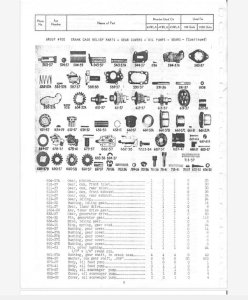-
Posts
11,972 -
Joined
-
Last visited
-
Days Won
369
Content Type
Profiles
Forums
Gallery
Downloads
Blogs
Events
Our Shop
Movies
Everything posted by old man emu
-
Yeah. It seems to be the border between sub-tropical and temperate weather systems. It has been hot, dry and windy here all summer. The grass in the paddocks is dead. I wondering if there is enough soil moisture for a winter crop to be sown.
-
Looks like I'm going to keep pretty dry. Them pesky rain clouds are avoiding my place. Wouldn't like the drought to end.
-
This clip highlights the absolutely stupid consequences of Trump's DEI directive.
-
Politics in Australia has generally been a two-horse race, Conservatives -v- Labor. The minor parties are subsets of either one. So we expect the overall vote to be close to 50-50. When one of the horses in the race gets beaten by a furlong, you've got to wonder why. I would expect the Nationals to win seats in agricultural areas. The Libs have to battle it out with Labor in urban electorates. On that basis I suggest that the loss was the fault of the Libs. What have they done to make the electorate think they stink? Could Gina be a factor? From some of Onetrack's posts, I get the opinion that Labor has made an effort to return the wealth of the State to the people in ways that don't seem to be 'bread and circuses'.
-
Isn't it good that in Australia all one has to do is lodge an enrolment form and your name goes on the electoral roll forever? All you have to do is update your residential address if you move, or if you change your name. I really think that Australia has the best electoral procedures to allow a person to exercise the right to vote.
-
What would the World we live in be like if the bloke who invented the screw thread was left-handed?
-
Not one cent that has gone into Musk's pocket has been wasted.
-
I wasn't taking a shot at Albo. I just wanted to make a smartarsed shot at Trump. My source for Albo saying that it was not the right moment to commence an election campaign was a press conference he gave dealing mainly with the cyclone emergency. His comments about the election were in response to a red herring question from some dumb journo. You could take a guess at which media outlet the journo worked for. I'm looking forward to tomorrow's Sunday Telegraph to read its reports on how the three levels of government are handling the emergency. Not that I purchase that rag myself. My Mum gets it just for the horse racing reports. As far as I can concerned the Sunday Telegraph is such garbage that even the tea leaves object to being wrapped in it.
-
If Trump calls Zelenskyy a dictator because Z has not called for elections, does that also mean that, according to Trump, Albanese is a dictator, too. After all, both Z and Albo have held off calling for elections while their country deals with serious emergencies.
-
Know the situation very well.
-
He deserves the title of "King of Con-fusion". If you stand back and look at what his Administration has/could do to the global economy and his threats of warlike actions, you'd have to compare what you see with the criteria that are used to define terrorist organisations.
-
Nup. You've clearly displayed your ability to carry a grudge for 50+ years. Time to lay your burden down.
-
Yes. The way Vietnam Vets were treated in the 1970s was bad. However, nowadays the Dept of Veterans Affairs is providing a great deal of support, which those Vets, and those from more recent conflicts, are getting. Yes. I know about the high suicide rate, but that is getting attention, too. A big problem is that because of the shit treatment handed out by the RSL to those Vets, they don't want anything to do with the RSL. That is a bad thing, because it is through the help of the RSL that these Vets can access what the DVA can provide. And GON, don't pooh-pooh what I've said. My sister and brother-in-law are helping their local Vets to access DVA every day. In another thread I mentioned that they have just got onto Starlink for internet access because their work on behalf of Vets occupies many volunteer hours per day. So if you make a wrong comment about the RSL or DVA, I'll come back like a shot with a rebuttal.
-
My problem is that I never developed the habit of drinking a lot of water, either raw or in beverages. My favorite drink during a hot day is cold milk, but that means my calorie intake goes up. Not keen on sugary drinks. I find that failure to drink a lot on hot days can lead to constipation.
-
Talking about the shape of Humanity. Australia's health problem is that in 2022, based on measured data from the ABS 2022 NHS (latest published data), of adults aged 18 and over: 66% were living with overweight or obesity, approximately 13 million adults. 34% were living with overweight but not obesity. 32% were living with obesity. In 2018, obesity cost the Australian community $11.8 billion and if nothing is done, may cost an estimated $87.7 billion by 2032. Seems we are digging our graves with our mouths.
-
Because the NBN and Telstra connectivity is so bad up my way, lots of people, especially out of town, have gone to Starlink. My sister joined up recently and is very pleased that now she can get on with her volunteer work much more efficiently. I'm working off a Telstra 4G dongle, which work well. My place must be in good line-of-sight to the transmitter.
-
Nevv-uh!
-
I usually can't see the forest for the trees, but my eye fell on the spring almost immediately. I wish I could find tools that I just put down on the bench as quickly!
-
Once she gets used to wearing the mask, you won't be able to stop her using the CPAP machine. She will sleep more soundly and wake refreshed. You will get better sleep as well as she will not be disturbing you, tossing and turning. I find that I wake up in exactly the same position as I was in when I closed my eyes. Also I fall to sleep within a few minutes. Unfortunately, my kidneys like night shift and I have to dispatch their product in the early hours.
-
There's our plan for defending ourselves! Everyone start hyperventilating!
-
Don't you remember the "class" wine of the 60s?
-
Why did he need the truck?
-
Did you ever think that the employer was looking for someone with current experience in the position they were trying to fill? While I acknowledge that you did your duty, infantry experience doesn't translate into private sector occupations. You were unlucky that your number was drawn. Think of your mates whose numbers were not drawn. While you were serving your country, they were gaining skills and experience in the private workplace. Reading between the lines of your above post, I get the idea that there is more to your story than it would be polite for me to seek out, so I won't. I'll give you that bit of respect, but will you give me a modicum of respect and quit this "suit your selfish egos" shit.
-
Let's not forget that the seals between surfaces of components of engines made that long ago were not perfect. Even the paper gaskets did not have an infinite service life. If you were a vehicle manufacturer, relying on continuing sales, year after year, would you be hoping that what you build today will run as well in 80 years as it does on Day One? I'm only lucky that this model of bike was built on a military contract. Production figures vary, but they range between 80,000 and 90,000 completed units. However there also had to be spare parts. Here is a page out of the spare parts book. The far right column shows how many of each part are required per 1000 complete bikes.
-
I'm about to pay $600 for a reconditioned oil pump for the WLA. A "new" one is over $US750, and I can't be sure that the new one is up to OEM specs. But that's what you have to pay for parts for 80 year old machinery. It was wiser to buy a complete pump than to buy to ball valve and spring, plus the tool to recut the valve seat and for me to try to do a job I know nothing about. Now all I have to do is undo some pipes; remove and replace the oil pump and reconnect the pipes. The oil pump works, but the ball valve is a check valve that stops oil draining from the oil tank to the crankcase when the engine is not running. I left the bike for a month and the oil tank drained onto the floor.









